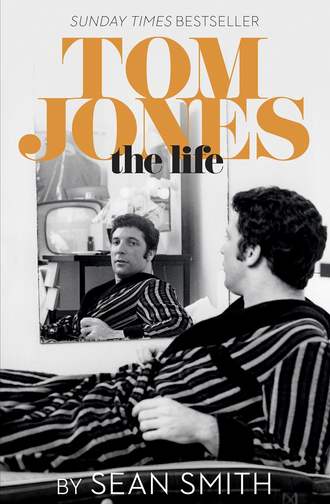
Полная версия
Tom Jones - The Life
By this time, Tom had embraced the new Teddy boy culture that was sweeping the country and Linda was happy to wear the uniform of the girlfriend. Becoming a Teddy boy was part of growing up for many young men who left school at fifteen and wanted to announce to the world that they had arrived. This was nothing like the gang culture of today, although it helped if you could handle yourself in a fight.
Teddy boys weren’t a natural product of rock ’n’ roll. The famous attire had been around for several years, ever since fashion leaders in Savile Row, London, had tried to reintroduce the Edwardian style to affluent upper- and middle-class young men after the end of the Second World War.
Gradually the uniform filtered down to working-class youths. They were known as working-class Edwardians until the Daily Express printed a story in September 1953 with a headline shortening Edwardian to Teddy and the term ‘Teddy boy’ passed into mainstream usage. The fashion lost its appeal to the middle classes when that happened, so the famous suits could be picked up for bargain prices on second-hand market stalls.
Tom was a Treforest Ted. He wore all the gear: gaudy waistcoats, cowboy hats, bootlace ties, black suede crepe-soled shoes, known as brothel creepers, and, his pride and joy, a sky-blue suit, consisting of a long jacket with a velvet collar and narrow trousers. Local journalist Colin Macfarlane memorably described Tom in the 1950s: ‘He could be seen walking along the streets with his Teddy boy coat and trousers that were reckoned to be as narrow as the thinnest drainpipe in the village.’
Tom always fancied himself in his Teddy boy finery. The proprietor of Linda’s drapery shop wasn’t so impressed when this dandified vision came to call during working hours. Tom may have thought he was the height of fashion but, to others, Teddy boy was synonymous with young hooligan. Linda had to make sure he stayed out of sight at the back of the shop during working hours.
Linda, who was always smartly turned out, had a figure that looked good in anything, especially the pencil skirts that were fashionable in the mid-fifties. She also had a DA haircut, which was a polite shortening of the coarser ‘Duck’s Arse’, so called because it resembled the rear end of a duck. In the US, where it originated, the style was known as a ‘Duck’s Tail’ or a ‘Tony Curtis’, after the heart-throb actor who popularised it. The cut was short at the back and long and curled over in a quiff at the front. The general idea was to pile as much of your hair onto the top of your head as you could, using slabs of hair gel to hold it in place. Tom had one as well, lovingly teased and shaped by Linda.
The young women were more impressed with his efforts than the men. One of the lads recalls Tom’s image: ‘He looked like a dipstick. Always did when he was younger – a greasy-haired gypsy.’
Brian Blackler, whose Teddy-boy suit was silver, remembers: ‘We would go down to Cardiff and see the boys down there with their hair like Tony Curtis and we would come home and copy them. We all looked the same then.’
After the working week was over, Saturday was dance night. The Teds would meet up in a pub for a few bevvies to start off the evening. Tom and Dai, who was a year younger but didn’t look it because of his size, would generally be served, because they seemed older than they were. The girls, meanwhile, would usually congregate at someone’s house before making their way to that night’s chosen venue. ‘We girls never touched alcohol,’ confirms Vimy. They would make do with crisps and lemonade and wait for the boys to arrive. The Ranch in Pontypridd, St Luke’s Church in Porth and the Catholic hall on the Broadway were popular for a night of jiving – at least until 10.30, when they had to play the national anthem and finish for the night.
Boys and girls would put on their best clothes on a Sunday afternoon and meet up in the centre of Ponty for what was known locally as the Monkey Parade – a weekly ritual in which the young men were like peacocks trying to attract the best-looking female. They would pair off for an innocent stroll through town. If Tom were delayed for any reason on the Saturday or Sunday, none of the local lads would chat up Linda, because she was strictly off-limits. She was Tommy’s girl.
4
The Making of a Man
Another rainy day in the autumn of 1956 changed Tom’s life for ever. As usual, he and Linda were sheltering in the phone box at the end of Laura Street, when she plucked up the courage to give him some news. Tearfully, she told him they were expecting a baby in the spring. Tom was now sixteen and she was fifteen.
They hadn’t bothered with contraception. There was no family-planning clinic in Treforest in those days. Tom admitted that he didn’t care about precautions, because he knew ‘I loved this girl’. He hadn’t given it a second thought until it was too late. He described his shock, ‘I thought, “Oh my God, what is my mother going to say. Or my father, what is he going to say!” The initial thing was “I am in hot water.”’
Despite his youthful swagger, Tom was still living at home and young enough for his mum to give him a clip round the ear and tell him to get his hair cut, which she frequently did when she noticed it was longer than Linda’s. He had huge respect for his parents and didn’t want to disappoint them.
Tom was right to be nervous. He later confided in bass guitarist Vernon Hopkins that his father was very angry at the news that he was going to be a grandfather. He thrust a wad of notes into his son’s hand and told him to head off to Cardiff and join ‘the bloody merchant navy’. When everyone had calmed down, Freda and Tom senior called a family conference to decide what should be done.
The meeting to decide the teenagers’ future was held in the best room at Laura Street, which was usually reserved for special occasions. While, strictly speaking, this was a very special occasion, it wasn’t a celebration. Linda walked round with her parents, Bill and Vi, then settled in a corner of the room with Tom, as the two families tried to agree a plan of action.
One option was ruled out right away. The Trenchards were a good Catholic family, so there was no question of an abortion, which, in any case, was still illegal in 1956. One solution, followed by many families, was for Linda to go away and ‘visit relatives’ for the later stages of her confinement, give birth and have the baby adopted. She could then return to Treforest refreshed and rested after a lovely ‘holiday’ and none of the neighbourhood gossips would be any the wiser.
A third possibility was that Linda could leave Treforest for a while, give birth and then hand the baby over to her aunt, who had no children, which would at least have kept the child within the family. None of these possibilities seemed ideal and the adults continued to try to reach an agreement. The whole time, Linda and Tom sat together, holding hands and whispering affectionately to one another.
Eventually, Freda noticed them. Tom recalled the moment, ‘My mother, God bless her, said, “Look at them. We’re trying to decide what’s going to happen and they’re oblivious to what’s going on. How can we get in the way of that?”’
Thomas senior asked his son what he wanted to do. Tom replied without hesitation: ‘I said, “I want to get married to Linda and she wants to get married to me.” My father just looked at me, it all went dead quiet for a moment, and then he said, “Go ahead.” I always loved him for it.’
It wasn’t quite as simple as that, though. Linda was not yet sixteen and was therefore too young to be married legally. They would have to wait until after her next birthday, on 14 January, and by that time there would be no hiding her condition. There was the wider family to convince that this was the right course of action as well. At least Tom’s mother and father weren’t hypocrites about their son’s situation: they, too, had married after Freda became pregnant – and that was in the 1930s. Tom’s cousin Margaret remembers her Auntie Freda telling her that Tom wanted to get married: ‘He wasn’t forced at all. Some parents might have done that, but he wanted to.’
Linda’s friends weren’t judgemental. While there was some inevitable gossip behind closed doors, Vimy Pitman recalls, ‘Everybody felt immensely sorry for her, because she was such a nice person. Nobody put her down. I didn’t know of any other pregnancy when we were that young. It was all so shocking. She was far too nice to say anything nasty about. You wouldn’t say, “Oh look, what has she been up to, then?”’
Any childhood dreams Linda may have had of a romantic wedding were put firmly behind her when, eight months pregnant, she and Tom made their way to the Pontypridd Register Office in Courthouse Street on 2 March 1957. At that time, it was still important to be married before giving birth, however late in the day.
Register offices haven’t changed much. It was an impersonal affair, with the cheery registrar, the master of ceremonies, seated behind a plain wooden table, while immediate family sat in rows on the facing chairs. Tom’s sister Sheila was there with her new husband, Ken Davies, who was one of the two main witnesses on the marriage certificate. Tom’s grandmother Ada, Aunt Lena and Uncle Albert, parents of the twins, were there and, of course, so were his parents, watching their teenage son grow up before their eyes. Linda’s parents were joined by some of her close relatives, including her aunt, Josie Powell, who was also a witness. Nobody realised then that Linda’s father, Bill, a quiet man like Tom senior, had only a short time left. He was battling tuberculosis – a grim reminder of how close to death Tom had come.
The ceremony was mercifully brief and the family retired to the Wood Road for a celebratory drink on the way home. It was very low key, but there were more pressing matters for the newlyweds to consider – where they were going to live and how they would provide for their child.
The living arrangements were easily sorted. Tom just packed his clothes and sauntered round to Linda’s, where the now Mr and Mrs Woodward were given the basement area of 3 Cliff Terrace as their first marital home. Linda’s parents and her younger sister Roslyn were on the floor above. Their living quarters were below the level of the street, so there wasn’t much natural light, but Linda set about making the place presentable. It was very basic, however, with no fridge, Hoover or phone. The old stove she had to cook on was something from the 1940s. Visitors would bang on the grill with a boot to attract their attention, although that was liable to set the dogs barking up and down the road.
Tom had taken on some extra shifts at the Polyglove factory to try to build up a nest egg to get them started as man and wife, but it soon became clear that he would have to look for something better paid. He started work as a general labourer at the British Coated Board and Paper Mills on the Treforest Industrial Estate.
Tom was just leaving on his bike to cycle to work for a night shift, when the ambulance drew up to take Linda to the maternity hospital in Cardiff. ‘I couldn’t even take a shift off when my wife went into hospital.’ Even if he hadn’t been working, this was the 1950s and long before prospective fathers were expected to hold their partner’s hand while she gave birth.
On his return from the mill the following morning, Tom dumped his bike on the pavement and excitedly rushed into the all-too-familiar phone box to ring the hospital. It was 11 April 1957 and Tommy Woodward, aged sixteen, was informed he was now the father of a baby boy.
Tom dashed to the hospital in Glossop Terrace. He can chuckle now about what he must have looked like. He told the 1991 TV documentary The Voice Made Flesh, ‘I walked to the hospital with a shopping bag, which I wouldn’t have been seen dead with the week before. I had this bloody Teddy suit on with a shopping bag. And I walked into the hospital and I saw Linda and my son and I came out of there and I thought, “Who can touch me now!”’
He took the bus home, but decided to stop along the way at one of his favourite dance halls to toast the birth. ‘I went into the toilet and one kid said, “Oh, we heard that you had to marry Linda Trenchard.” And I grabbed him by the throat and lifted him up, you know, on the wall and then people pulled me off. I was so “lifted” by the fact that I had a wife and little boy. It made me feel much stronger than I was a week before. It made me a man.’
Despite that feeling of masculine bravado, Tom’s situation was far from promising. He was a teenage father of one with no prospects. To a certain extent, Tom’s life was following the norm for this part of South Wales: boys would leave school at fifteen, go down the mines or find a factory job and then look to marry and settle down. Circumstance may have dictated that Tom started a year or two earlier than most, but the majority of his school friends were married, with young families, while they were still teenagers.
Family life for Tom began with some grim news. Linda’s father had to go into hospital as his tuberculosis worsened. Bill Trenchard died from TB just six weeks after the birth of his grandson, Mark. He was forty-two. Linda tried to rally round her mother and younger sister, but she had to care for her baby. Tom did his best to be supportive and, for a short time at least, was very attentive to his young family. He went everywhere they went. Brian Blackler recalls that the first time he saw Mark Woodward was when Tom was walking on the Feathery with his little boy perched on his shoulders. He was clearly a proud new dad.
Tom’s routine began to follow a pattern remarkably similar to that of his father. During the week he worked hard, and on Friday nights enjoyed a beer with his mates at the Otley Arms in Treforest or the White Hart pub in the area between the village and Pontypridd known as The Tumble.
Brian also left the glove factory and started work at a local pit, the Maritime Colliery in Maesycoed, on the outskirts of Pontypridd, so Tom inevitably saw less of him as time passed. Tom still enjoyed the company of his old friends, but his best mate as the years went by remained Dai Perry. In Dai’s own words, they were like brothers, and they forged a lifelong bond, supping pints together and getting into scraps. It was a time when Tom’s nose was reshaped many times. He later complained to the renowned journalist Donald Zec, ‘I hate my horrible nose – it’s been worked over, bent sideways and patched up more than any other part of me. And always hit by a head – we liked to keep our hands nice and smooth like.’ His crooked teeth weren’t much better.
Generally speaking, Tom and Dai didn’t go looking for trouble. It had a habit of finding them, however, usually when one beer too many had been downed. On one memorable occasion, Tom was head-butted so hard, he ended up flying through the plate-glass door of a fish and chip shop.
The fight had been brewing for several days, after a row and a frank exchange of insults outside an Indian restaurant had resulted in Tom punching a man he described as a hooligan. The word went out in the days that followed that the man’s friends were looking for Tom to even the score. Dai warned him to be careful, but Tom was sure he could handle any trouble. He told Dai overconfidently, ‘He’s got no chance.’
Sure enough, the man – and his father – caught up with Tom as he ate some chips in the doorway of a Ponty takeaway. Tom has never been slow to tell the story of his comeuppance: ‘I told him, “Why don’t you run along?” Dai whispered to me, “Keep an eye on him,” but I didn’t care. I said, “Where do you want to go?” and while I was talking, he suddenly let me have it and I smashed right through the door into the fish and chip shop.’
He was still scrambling to his feet, ready to continue the fight, when the police arrived and moved everybody on. Tom, fuelled by the beer, followed the pair up to the Graig, where they lived, and jumped on them without even bothering to take his overcoat off. It was a big mistake, because there were two of them. That became three when the man’s mother charged out of their house, and four when his brother arrived as well. As Tom put it succinctly, ‘They beat the shit out of me.’ He still has the scar where one of them bit him on the finger.
Dai Perry looked on while his friend took a beating. Although he could have sorted things out for Tom, he did nothing because of an unwritten code of conduct: you couldn’t fight a woman or a much older man, especially if he was someone’s father. It was a question of respect, and Tom never held it against him.
On the streets of Pontypridd, the Teddy boy rules did not, for the most part, include the use of knives. Drugs weren’t a feature of the lifestyle either, and Tom never saw the point of narcotics. Instead, it was a macho culture of beer, Woodbines and the occasional brawl. Brian Blackler is adamant that Tom didn’t deserve his reputation as a ruffian: ‘He could look after himself, Tom, but he wasn’t a fighter. I think most of the boys were like that in them days. We wouldn’t get bullied, would we? I never liked a bully and I wouldn’t get bullied and Tom was the same.’
Despite not looking for trouble, there were many nights when Tom greeted his wife with a black eye or a fat lip after a night out. There must have been a lot of bullies in Pontypridd then. An evening rarely ended without some sort of punch-up between those Teds who were looking for trouble. If you went out to a dance hall in town, you needed eyes in the back of your head to keep watch for any menacing Ted sneaking up on you from behind. The British Legion in Rhydyfelin was so notoriously rough that it became widely known as the ‘Bucket of Blood’.
The history of that era reveals that there were some massive fights between rival gangs of Teds. But Keith Davies, who later played guitar alongside Tom, observes: ‘Sometimes I think the whole Ted thing is overcooked. It was just a way of life for everyone. Everybody was a Teddy boy. I wouldn’t say Tom was a tough Ted. He was aggressive on stage though.’
Tom, meanwhile, was promoted at work to a job as a machinist. As a result, he was earning more money, but alternate weeks he had to work a night shift from 6 a.m. to 6 p.m. Even that small advancement was threatened by an overzealous trade unionist, who complained that he was too young to receive a man’s wage. Tom had to hold his tongue – and his fists – when some of the other staff tried to sabotage his machine so he would be out of favour with management. He began to hate his job.
Letting off steam with his mates was poor compensation for his general unhappiness at the way things had turned out for him. He was linked to some petty crime in the area, which gave Freda some sleepless nights, worried that the next knock on the door might be someone ready to arrest Tom. Mostly, though, it involved sneaking into the cinema without paying or nicking the occasional 45 from the record store.
He laughed the troubles off: ‘When the officials came to see my mother with the brasses nicely polished in the front room and a picture of granddad with his medals on, they went away saying, “No ruffian could live here!”’
Perhaps most alarmingly, he temporarily lost his appetite for singing, weighed down by his responsibilities. Linda, whose contribution to Tom’s career should never be underestimated, had to prod and cajole him into singing again, starting off while shaving in the mirror before work. She was delighted when he came home one afternoon in early 1957 with a new single in his hand.
Tom had been walking through the centre of Pontypridd, when he heard ‘Whole Lotta Shakin’ Going On’ by Jerry Lee Lewis for the first time. It was blasting out from the speakers at Freddie Feys’ record shop. He was immediately stopped in his tracks: ‘Good God. To me that was it! I loved that record and it was a white man singing boogie-woogie that he had heard black men play.’
Tom would never forget the effect Jerry Lee’s music had on him. He admired Elvis and would spend afternoons listening to Brian’s elder brother John’s collection of The King’s records. But he loved the man from Louisiana, who was known as ‘The Killer’. Tom liked his aggression and the way Lewis would chew his audience up and spit them out. He was a white man who sounded like he was black, and that was the effect Tom had always wanted.
At least money wasn’t as tight and he could buy a new Hawk guitar. He was earning £18 a week and they weren’t paying any rent. Until now, Tom had sung at school and family get-togethers. It was time for him to start singing in public.
Urged on by Linda, he approached his uncle, Albert Jones, to ask if he could perform at the Wood Road. ‘Could you put us on, Uncle Albert – you know, do a gig down there?’
Albert, who was quite a stern chap, replied, ‘It will never go down well here – rock ’n’ roll.’
Tom persevered, however, and eventually he had a lucky break, when an act they had booked failed to show one Sunday evening. Tom stepped up and sang three numbers, including the classic Elvis hit ‘Blue Suede Shoes’ and ‘Sixteen Tons’, a number one for Tennessee Ernie Ford in 1956. The reaction was much more favourable than Albert had expected, so Tom came back after an interval and sang three more. Afterwards, the club’s entertainment secretary, Charlie Ashman, was so pleased, he put his hand in the till and handed Tom a £1 note. In those days of pre-decimal money, he could buy thirty pints in the club for a quid. The only problem was that everyone knew how old he was and he could never get served there.
Tom was encouraged to think he could sing for money, or at least beer money, in the pubs and clubs around Treforest and Pontypridd. His mates supported him, especially when he started singing at one of their favourite pubs, the Wheatsheaf, at the bottom of Rickards Street. They would have a few beers in the downstairs bar before adjourning to the room upstairs, where Tom would belt out his mix of Jerry Lee Lewis, Elvis and Ray Charles numbers, accompanying himself as best as he could on his guitar.
The audience loved him at the Wheatsheaf, but it was practically his local and didn’t really count. The landlady, Joan Lister, recalled that the audience wouldn’t get up for a pint when Tom was on, which may or may not be true. He needed more than that generous appreciation, however, and for a while joined a local beat group called the De Avalons. He was the drummer, not the singer, but soon tired of that arrangement, much preferring to be the centre of attention.
He joined a concert party called The Misfits. These variety ensembles, which often included a comedian and a group, were very popular. They were like a mini evening of Britain’s Got Talent. Tom liked the set-up, because the money was good – anything from £2 to £5 for a night’s work – and he found he could earn almost as much at a weekend as the rest of the week in the paper factory. Tom was one of three acts, which included a singer who specialised in Frankie Laine numbers.
Linda had no objection when Tom decided to quit his job at the paper factory and sign on the dole. Tom was reassured by a workmate, who told him, ‘If you fail, you can always return. It doesn’t take a genius to work in a paper mill.’ He needed to be free from shift work so he could accept evening bookings. From time to time, he would take a job selling vacuum cleaners or working on a building site, carting bricks, but his heart wasn’t in it and these jobs rarely lasted more than a few weeks. His only ticket out of the Valleys was with ‘singer’ stamped on his passport, so he was much happier concentrating on that ambition than grafting for a few pounds a week. The reality was that he had started to drift.
The most significant member of a Tommy Woodward audience during this time was a young guitarist from Rhydyfelin called Vernon Hopkins. He had heard about a rough and ready lad with a big voice doing his time on the pub and club circuit around Pontypridd, so he turned up at the Wheatsheaf one night to watch Tom perform. Vernon was unimpressed with his act, but admired his voice.







